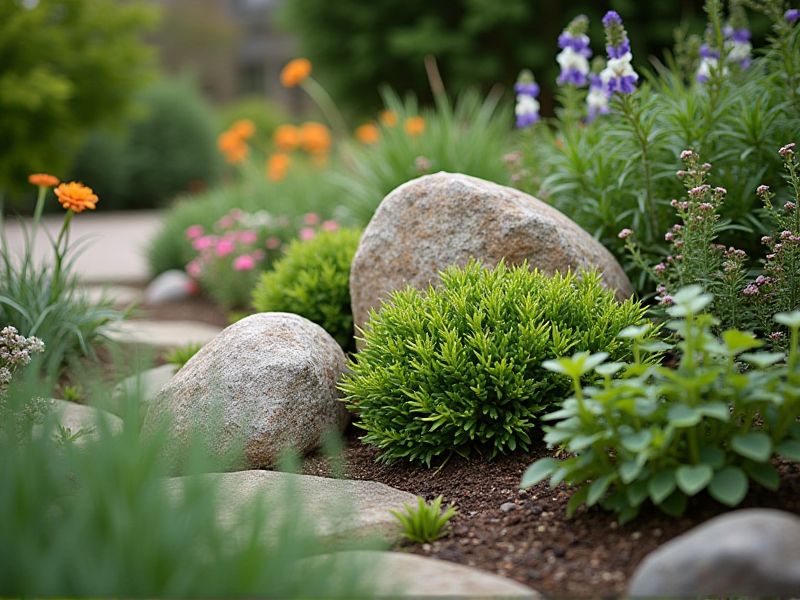
Rock garden plants, such as succulents and alpine species, thrive in arid conditions and demand minimal watering. Varieties like Sedum and Sempervivum are particularly suited for rock gardens, exhibiting drought-resistant characteristics and vibrant colors. Additionally, native plants like Dianthus and Artemisia not only enhance visual appeal but also significantly reduce water needs. By incorporating these robust species, you create a low-maintenance landscape that conserves water while providing year-round interest. Your rock garden can become a sustainable oasis, showcasing nature's resilience and beauty.
List of some Rock garden plants that require minimal watering
- Ice Plant (Delosperma cooperi)
- Sedum (Sedum spp.)
- Lavender (Lavandula spp.)
- Blue Fescue (Festuca glauca)
- Thyme (Thymus spp.)
- Hens and Chicks (Sempervivum spp.)
- Rock Soapwort (Saponaria ocymoides)
- Blanket Flower (Gaillardia spp.)
- Russian Sage (Perovskia atriplicifolia)
- Creeping Phlox (Phlox subulata)
Important things about Rock garden plants that require minimal watering
Drought-Tolerant Species
Rock garden plants are ideal for creating stunning landscapes while conserving water, especially in arid climates. Varieties such as Sedum and Sempervivum thrive in rocky soil, requiring minimal watering once established. These drought-tolerant species offer a range of textures, colors, and forms, ensuring visual appeal without excessive maintenance. By incorporating such resilient plants into your garden design, you can achieve an environmentally friendly space that flourishes with little irrigation.
Native Plants Adaptation
Rock garden plants are an excellent choice for creating a low-maintenance landscape while featuring native species adapted to arid conditions. These resilient plants, such as sedums, sempervivums, and dwarf varieties of ornamental grasses, thrive in well-drained soil with minimal watering needs. Their deep root systems allow them to absorb moisture efficiently, making them ideal for xeriscaping projects. Incorporating these native plants not only conserves water but also supports local wildlife, enhancing the ecological balance of your garden.
Succulent Varieties
When designing a rock garden, incorporating succulent varieties can enhance both aesthetic appeal and water efficiency. Notable species include Echeveria, known for its rosette shapes and vibrant colors, and Sedum, which offers a diverse range of textures and forms. These drought-resistant plants thrive in well-draining soil and typically require minimal watering, making them ideal for low-maintenance landscapes. Your rock garden can flourish with these hardy succulents, providing a stunning visual display while conserving water resources.
Deep Root Systems
Rock garden plants with deep root systems, such as sedums and sempervivums, thrive in arid conditions, making them perfect for low-water landscapes. These plants efficiently access moisture from deeper soil layers, reducing the need for frequent watering. Xeriscaping with such species not only conserves water but also promotes biodiversity by providing habitat for local wildlife. Incorporating these resilient plants into your rock garden can enhance aesthetic appeal while ensuring sustainable gardening practices.
Soil Drainage Importance
Soil drainage is crucial for rock garden plants, as it prevents waterlogging and root rot, ensuring the health and longevity of these drought-resistant species. Efficient drainage systems, such as gravel or sand mixes, allow excess water to escape quickly, mimicking their natural environments and facilitating oxygen exchange in the root zone. By choosing plants like sedums, sempervivums, and other succulents, you can create a low-maintenance rock garden that thrives with minimal watering. Prioritizing well-drained soil not only supports plant growth but also enhances the overall aesthetics of your garden by promoting vibrant colors and varied textures.
Mulching Benefits
Mulching in rock gardens can significantly enhance the growth of drought-resistant plants by reducing evaporation from the soil, thereby conserving moisture. By using organic materials such as shredded bark or gravel, you create a barrier that also suppresses weed growth, allowing your plants to thrive without competition for nutrients. This practice not only regulates soil temperature but also adds aesthetic appeal, harmonizing with the natural stones of the garden. For rock garden enthusiasts, implementing effective mulching strategies can lead to healthier, more vibrant plants while minimizing water requirements.
Sun Exposure Preferences
Rock garden plants thrive in well-drained soil and require minimal watering, making them ideal for sunny spots. Succulents like Sedum and Sempervivum not only tolerate dry conditions but also bring vibrant colors and unique textures to your garden. Drought-resistant perennials, such as Dianthus and Achillea, excel in full sun and add visual interest with their striking blooms. By selecting these hardy plants, you can create a low-maintenance garden that maximizes sun exposure while conserving water.
Minimal Fertilization Needs
Rock garden plants that require minimal watering often thrive in dry, well-drained soil, making them ideal for xeriscaping. Succulents such as Sedum and Sempervivum not only display stunning foliage but also store water efficiently, reducing your need for irrigation. Drought-tolerant perennials like Ice Plant and Alpine Aster add vibrant colors while surviving in low moisture environments. By selecting these robust species, you can create a beautiful, low-maintenance garden that conserves water and nourishes biodiversity.
Seasonal Pruning Tips
For your rock garden plants, seasonal pruning is essential to promote healthy growth and minimize water needs. Focus on trimming dead or diseased branches to improve air circulation and reduce the risk of fungal infections, which can thrive in damp conditions. Certain drought-tolerant species, like sedum and thyme, benefit from light pruning to encourage denser foliage while maintaining their low-water requirements. By timing your pruning just before the growing season, you help your plants maximize sunlight and reduce their overall water consumption throughout warmer months.
Pest Resistance Traits
Rock garden plants, such as sedums and echeverias, often exhibit remarkable pest resistance traits, making them ideal for low-maintenance landscapes. These succulent varieties thrive in arid conditions and require minimal watering, allowing them to flourish in well-drained soil while deterring pests like aphids and mealybugs. Their fleshy leaves not only store moisture but also produce natural compounds that repel harmful insects, ensuring a healthier garden ecosystem. By incorporating these resilient plants into your rock garden, you can enjoy vibrant foliage and flowers without the constant worry of pest invasions.
